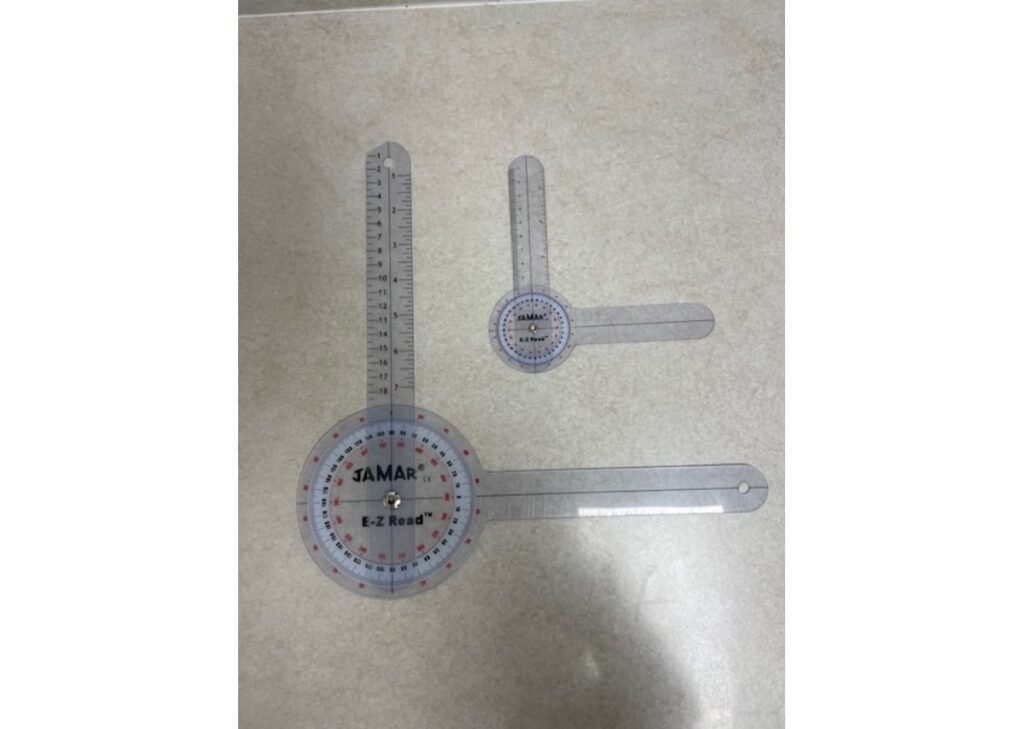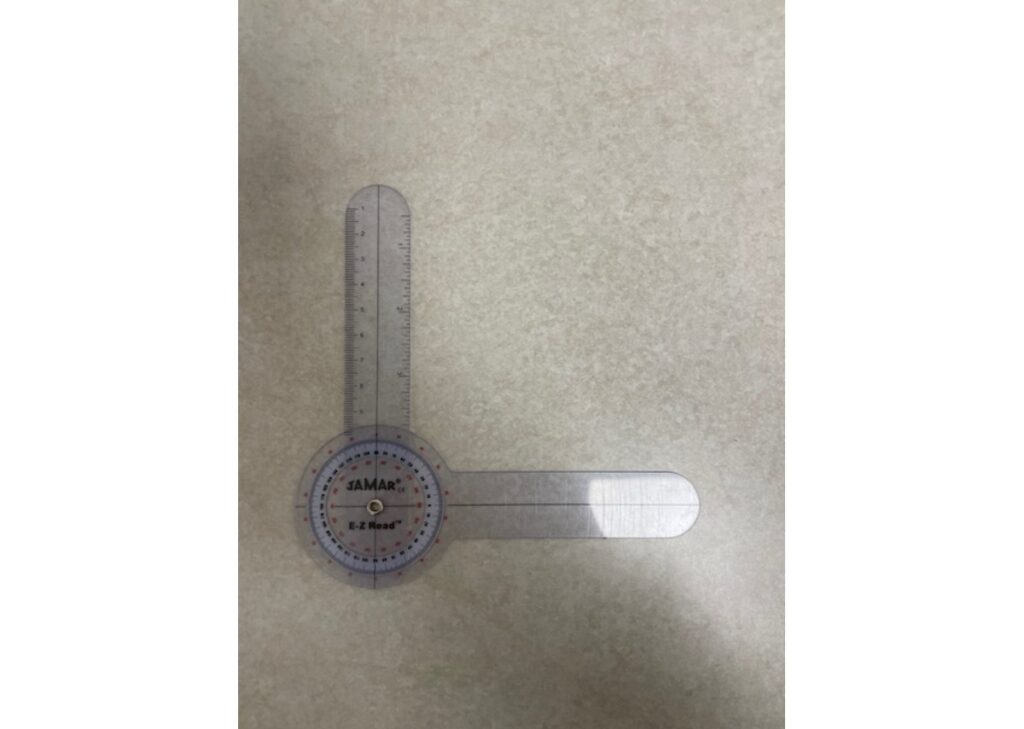Introduction to the Goniometer

In healthcare, precision is paramount. One tool that underscores this precision is the goniometer. This simple yet vital instrument plays a critical role in assessing and monitoring joint health and mobility. For healthcare professionals, health care students, and occupational therapists, understanding the goniometer’s significance is essential. This post aims to unravel the mysteries of goniometry, offering insights into its practical applications and future potential.
Understanding Goniometry
A goniometer measures joint angles, providing an accurate assessment of a patient’s range of motion. This tool consists of two arms, one stationary and one movable, connected by a hinge. By aligning the arms with specific body parts, healthcare professionals can measure the angle between them. This measurement is crucial for diagnosing joint conditions and tracking progress during rehabilitation.
The process of using a goniometer is straightforward, but requires precision. The stationary arm is aligned with the proximal body segment, while the movable arm follows the distal segment’s motion. The hinge, or fulcrum, is placed at the joint’s axis of rotation. This setup allows for an accurate reading of the joint angle, which can then be compared to standard ranges of motion.
Importance in Healthcare
Goniometry holds a significant place in healthcare. It aids in diagnosing joint disorders, such as arthritis, by providing objective data on joint function. Regular goniometric assessments can monitor disease progression and the effectiveness of treatment plans. This data-driven approach ensures that healthcare professionals can make informed decisions about patient care.
For rehabilitation purposes, goniometry is indispensable. It helps track a patient’s recovery progress, ensuring that therapeutic interventions are effective. By regularly measuring joint angles, therapists can adjust treatment plans to better suit a patient’s needs. This iterative process is key to successful rehabilitation and optimal patient outcomes.
Goniometer Techniques

Several techniques are employed when using a goniometer, each tailored to specific joints and conditions. The universal technique involves aligning the goniometer’s arms with anatomical landmarks and measuring the angle directly. This method is versatile and widely used in clinical settings.
Another technique is the gravity-dependent goniometry, often used for assessing lower limb joints. Here, the goniometer is equipped with a gravity pointer that aids in measuring angles accurately, even when the patient is positioned differently. This technique is particularly useful when measuring range of motion when a patient is in bed.
In some cases, digital goniometers are used. These devices offer enhanced precision and ease of use, with digital displays providing immediate readings. They are particularly beneficial in research settings, where high accuracy is paramount. Each goniometer technique has its place, and the choice depends on the specific clinical scenario.
Practical Applications of the Goniometer
In clinical practice, goniometry is used extensively. Orthopedic surgeons rely on goniometric measurements to assess joint functionality before and after surgeries. This data helps in planning surgical interventions and evaluating their success. Similarly, physiotherapists use goniometers to tailor rehabilitation programs to individual patients, ensuring targeted and effective treatments.
Occupational therapists measure joint angles, to develop goals and design interventions that enhance a patient’s ability to perform daily activities. For example, a therapist might use goniometric data to develop exercises that improve hand function in patients with arthritis, thereby enhancing their quality of life.
Future of Goniometry
The future of goniometry looks promising, with advancements in technology paving the way for more sophisticated tools. Wearable goniometers, which continuously monitor joint angles during daily activities, are on the horizon. These devices could revolutionize patient monitoring, providing real-time data and enabling proactive interventions.
Another exciting development is the integration of goniometers with digital health platforms. By syncing goniometric data with electronic health records, healthcare providers can gain a comprehensive view of a patient’s joint health over time. This holistic approach could lead to more personalized and effective treatment plans.
Conclusion
In conclusion, the goniometer is an indispensable tool in healthcare. Its ability to measure joint angles with precision aids in the diagnosis, monitoring, and treatment of various joint conditions. For healthcare professionals, occupational therapists, and medical students, understanding and mastering goniometer techniques is crucial. As technology advances, the role of goniometry is set to grow, offering exciting possibilities for improved patient care.
By staying informed about these developments and incorporating goniometric assessments into clinical practice, healthcare providers can ensure the best outcomes for their patients. Whether you’re a seasoned professional or a student just starting your journey, the goniometer is a tool worth mastering.
The information provided on this website is for general informational purposes only. It is not intended as, nor should it be considered, professional or medical advice. Always consult a professional regarding your specific medical issue.
Frequently Asked Questions
What is a goniometer, and how is it used?
A goniometer is an instrument designed to measure the angles of joints, providing healthcare professionals with essential data regarding a patient’s range of motion. It can be employed in both clinical and rehabilitation settings to assess joint function, monitor progress, and adapt treatment plans as needed.
How do I ensure accurate measurements with a goniometer?
To achieve accurate measurements, it is crucial to correctly align the stationary arm of the goniometer with the proximal segment of the limb and the movable arm with the distal segment. Care should be taken to position the fulcrum at the joint’s axis of rotation. Consistency in body positioning and the use of anatomical landmarks will enhance measurement precision.
Are there different types of goniometers?
Yes, there are various types of goniometers, including universal goniometers, gravity-dependent goniometers, and digital goniometers. Each type has specific applications and benefits, depending on the clinical scenario. Digital goniometers, for instance, provide immediate readings which can be helpful in research and clinical practice for tracking patient progress.
How often should goniometric assessments be performed?
The frequency of goniometric assessments depends on the individual patient’s condition and the treatment plan in place. Typically, it is beneficial to conduct assessments at key points during treatment, such as at the beginning of rehabilitation, mid-way through, and at the conclusion, to ensure a thorough understanding of the patient’s progress.
References
- Norkin, C. C., & White, D. J. (2016). Measurement of Joint Motion: A Guide to Goniometry. FA Davis Company.
- Hodge, M. (2018). “An Overview of Goniometric Techniques and Their Clinical Significance.” Journal of Orthopaedic & Sports Physical Therapy, 48(10), 834-842.
- Cattaneo, D., et al. (2020). “The Role of Technology in the Future of Goniometry.” Physical Therapy Reviews, 25(3), 155-162.
- Stark, W., & Clarke, J. (2019). “Goniometry: Best Practices and Protocols.” Rehabilitation Research and Practice, 2019, Article ID 4793672.
- American Physical Therapy Association (APTA) . (2021). “Clinical Guidelines for the Use of Goniometric Assessments.”
Looking for More Interesting Reads? Check Out the Latest Posts on OTInsider
